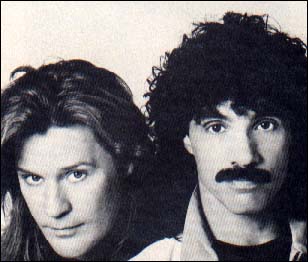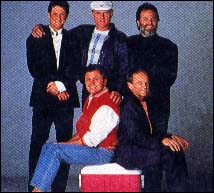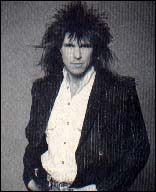THE MUSIC MAKERS
When It Comes to MIDI, the Pros Go ATARI
BY JIM PIERSON-PERRY WITH STEVE MORTIMER
What backstage secret do the Beach Boys, Blue Oyster Cult, Hall and Oates, Madonna and the Rolling Stones share? They have Atari hardware and software hidden among the cables, amps, synthesizers and mikes. START talked with the people who work with the ST in live performance, studio recording, synth sound banks and home demos.
Mike McKnight
On Tour with Madonna
While not a household name to her legion of fans, Mike McKnight is one of the key people keeping Madonna's "Blonde Ambition" tour true blue and pumping out the music, night after night.
He uses two Stacy 4s to coordinate MIDI and keyboard activity for the show. Although McKnight's MIDI experience stretches over six years, beginning with a Commodore 64 and a Dr. T's sequencer, his colleagues questioned his judgment when he brought his Atari on the Madonna tour.
 |
"Some guys at first pushed me to bring in a 'real computer,' a Macintosh," McKnight recalls. "I said give me a week with the Atari and if you don't like the way it feels then I'll gladly get a Mac."
These days, they sing a different tune. "Everybody on the tour is driving me crazy wanting a lot of Stacys," McKnight laughs. "We've got some Macs out here. One guy in particular, in the last three weeks his Mac has broken down three times. It has eaten up everything on his hard drive.
"Over all those years [my 1040ST] has never once broken down. I've had it in monsoons in the Philippines and horrible power situations and it never, ever gave me any problems."
McKnight describes his role on the tour as "enhancement. Some songs have a lot of sequenced bass or other parts that are kind of mundane but necessary. My sequencing frees the live band up to play much more interesting parts. It's a nice combination. Some background or lead vocals are sampled but used strictly to enhance the live singing. I play parts underneath the stage ... because I've got too much going on down there to be out on stage."
A pair of 4MB Stacys drives the sequencing. For software, McKnight sticks with the latest incarnation of Dr. T's KCS Level II for sequencing and XOR, Dr. T's new generic patch-editor librarian program, to handle sound backup for the different synthesizers. The only drawback he sees to KCS is its 16-channel limitation. "Hopefully they'll go up to 32 or 48," he says.
McKnight automates his end of the show, setting the timing to tight precision. "Sometimes I have to start a hard drive loading at a specific time and, as soon as it's done, boom--a quarter note later there are parts coming out of it. There's no margin for error," he explains. "They push a button on a T1 [synthesizer] on stage and all their program and volume changes are done. Other times I'm doing things where I have an audio patcher switch between samplers. There might not be enough time between songs to load up the next sampler, so you have to switch to another one going down the same audio line."
Despite all the seeming complexity and frantic pace, McKnight follows one rule to keep control. "I prefer to keep things simple and separate so that if one thing crashes the whole show won't stop. There have been times when the guys miss the count-in on a click, the drummer picks up the time and I have to punch in on bar 10 manually--that gets the heart going! There are some songs with a real important sequenced-bass part that the dancers do moves to. If it's not there..."
In keeping with his rule, McKnight starts all sequences with commands to set MIDI controllers and volumes to default states. "The less you have to go wrong, the better."
Hall and Oates
 |
STarting Over
START caught up with John Oates and technical coordinator Pete Moshay at the Hit Factory in New York, where the group is putting finishing touches on their forthcoming "Change of Seasons" album.
Their current effort returns to live ensemble playing. As Oates explains: "The technology for recording today is just fantastic. [You can] stay in the digital realm and keep the music within the sequencer and never really have to go to tape. We've come full circle now, I think. Instead of using sequencing and sampling as the heart and soul of our music, it has been integrated into the totality of the way we create. It's now just another tool. Some of the more hightech equipment is really playing much more of a supporting role than a feature role."
Possibly a surprise to many, Hall and Oates have used synthesizers and related electronic-music technology almost since they began recording together. "On our 'Abandoned Luncheonette' album in 1973 we used an ARP 2600," Oates recalls. "We also had one of the first consumer Mellotrons which came into the country." While electronic music was important in their work, it never really came to the front until 1985's "Big Bam Boom" album. This featured top-of-the-line instruments such as the Synclavier and Fairlight, along with drum machines and experimental tape techniques.
Now they use a 1040ST. Why Atari? Moshay explains: "You didn't have to use peripherals to get into the system and start using it. It is a more compacted system and more music-oriented than other computers."
 |
| John Oates and producer Pete Moshay use the 1040ST as a sequencer and patch librarian. |
The band's current configuration includes a color monitor, hard drive and modem. Hall and Oates also have been road testing the MegaFile 44 removable hard drive with great success. They store sound sample files for an Akai S1000 sampler on it. Notator software handles the sequencing chores while OmniBanker organizes their synthesizer patch files.
"We use it [the ST] a lot of ways," Oates states. "The last album we did was very much sequencer/synthesizer oriented. Finished songs were basically digitally sequenced and went to tape that way. The [new] record isn't something that was recorded and created on sequencers. A lot of times we'll use a drum-machine loop or certain sequence pattern that will be a starting off point. We'll record the keyboard part live but also record it into the sequencer as well, then come back and quantize it later if the part isn't feeling right. It gives us a lot more flexibility. [The ST is also used] for librarian purposes ... so that our keyboard players can easily access all these millions of sounds that we have.
"You really need to have something to manage those possibilities or it becomes overwhelming," he adds.
Moshay points out that the ST "makes the music process more visual for everybody. Instead of a little twoline readout you get a full-color screen of what you are doing. You can call up a bank of 200 sounds at one time and see them in front of you--something might inspire you."
After the album wraps, Oates expects to make more use of sequencing for live shows. "There are certain things that we'll come up with on the record that perhaps we don't have the right personnel or instruments for on stage, especially background vocals. We'll sample them and use those on stage to enhance the live background."
The crew also relies on the ST for telecommunications. "We go on-line and get chart information as well as transmit letters to the office from the road," Moshay explains. And for the odd free minute, ST versions of Monopoly and bowling help pass the time.
Electronic-music technology appears likely to continue as part of the Hall and Oates sound. "I'd like to have an open avenue to pursue anything I want to," Oates muses. "The way technology has become more and more user friendly over the years makes it even easier and more fun to use it because you don't have to break the creative flow in order to get into an electronic instrument. Writing songs is my main interest; anything that makes that process go quicker and fulfill the expression you want is positive."
Ron Riddle
|
|
Keyboards for the Cult
Ron Riddle, keyboard player for heavy-metal group Blue Oyster Cult, is a recent convert to Atari-based music systems. "I used to have an IBM and used the sequencer program Texture. I did a lot of work in that and actually wrote an entire album with it. Last November, I moved up to an Atari 1040ST."
Because of space constraints, a common problem for both hobbyist and pro, Riddle set up his home studio with a single controller keyboard (DX7) and assorted rackmount synth units (Proteus and M3r). The 1040ST acts as the central controller, for both sequencing and patch editing. "I have the Dr. T's patch editor for the Proteus, but am just starting to get into it," Riddle confides.
No hesitation about sequencing software, however. "I use Notator, it's great," Riddle says. "The scoring display is great for editing. You have the score right there to check things out, edit right from it."
With Blue Oyster Cult, Riddle plays live, but he's begun to use the Atari on stage in a song he plays with The Red and the Black, a spinoff band of three fifths of the Cult.
An enthusiastic new Atari user, Riddle looks forward to exploring other ST applications, especially games and telecommunications. Who knows? The next Cult album may feature "Don't Fear The Modem!"
James Grunke
Cruising with the Beach Boys
Synth programmer, keyboard technician, resident MIDI wizard--James Grunke handles all these roles for the Beach Boys. A trained classical pianist and arranger in his own right, Grunke happily discusses anything about music, from theory to the nuts and bolts of its production. And the Beach Boys, Grunke states, produce their music on Ataris.
"We have two systems [1040STs, hard drives, monochrome monitors plus musical gear] so we can set up and do two shows in two different cities in the same day," Grunke says. "The computers are primarily used on tour to handle patch storage and editing. All Beach Boys vocals are done live; there are no sampled vocals at all."
 |
While the 1040STs currently work well, Grunke hopes to move to the new Stacy portable, using it as the main patch point for the whole keyboard rig. He applies the same forward thinking to mass storage hardware, after seeing the MegaFile 44 removable hard drive at the NAMM show in January.
Grunke chose C-Lab's Notator for the group's sequencing needs. "It is awesome," he raves, having used the program for a video's theme song and the "Island Girl" cut on the latest Beach Boys album. He has no problem reconciling his classical training with sequencing. "I think it is a great tool. With the resolution they [sequencing programs] have now, I don't see any difference between MIDI data and just going directly to tape."
Off the tour circuit, group members often are found using Atari-based, home music studios that Grunke helped set up. While sequencing remains an at-home need, patch editing and management is a major task both in the studio and on tour.
"We use a lot of keyboard gear so I keep all the editing stuff on the Atari," Grunke says. "I bought GenEdit because I met Tom [Bajorus, the program's author]. He offered me individual support on it so I decided to take advantage of it. I hope to ... have a program where the Stacy would receive one program change and set up my entire rig. One button-push for the whole thing; that's yet to be developed."
Beyond music applications, Grunke uses ST word processors and data managers. His latest interests are in Macintosh and IBM emulation. "I need to be compatible with our management," Grunke explains. "That way, I can keep track of our [equipment] manifests without having to go over to their laptops."
Grunke is firmly convinced that Atari represents the most realistic choice for a musician. "My first computer was an Atari 800XL," he recalls. "I've used Macintosh and IBM computers quite a bit, but was turned on to the Atari STs at the Grove School of Music. Because of their price point, they are going to sell the most units and have the most support by third-party software writers. I see the Atari as the musical-standard computer for the future."
John Mordes
Record Producer, Atari Rep
Turning to the other side of the console, START spoke with independent producer John Morales. Morales' client list reads like a who's who of rock'n'roll: Mick Jagger, Hall and Oates, Heart, Debbie Gibson, Stevie Wonder, The Thompson Twins. "I've been involved with 576 records over the past eight years," he says, and, as if he's not busy enough, Morales acts as Atari's MIDI representative in New York City.
Morales uses several Atari systems in his lower-Manhattan preproduction studio. "We've got two Mega 4s and a 1040ST. [The studio] has a 16-track [recording] room and two workstations. People do the [synth and sampler] programming in the other rooms and, once we get to a certain stage, we move them into the big room.
"Before I got the Atari stuff, we did it live. I've only been using computers since 1985. I started with [Hybrid Arts'] Edit Track on the old Atari 8-bit, but it was bogus and short lived. I got a 520ST which I upgraded to 2.5MB, and still have around, and used [Steinberg/ Jones'] Pro 24 sequencer. [Later] I moved up to Creator and Notator."
Morales is a software fanatic and tries as many programs as he can find. "Most of the software I discovered in my travels. I was using Notator at least a year before it came into the country. [On] all my travels abroad I'd try to get whatever the hippest thing was. Even though KCS was around, it was too complex for me to get into. I'm basically a Notator guy now."
Besides sequencing, a major portion of Morales's work involves finding the right synth patches or samples to give particular sounds to a song. "I use a lot of Steinberg/Jones editors--the M1, D50 and Avalon. We also use the C-Lab Explorer programs, OmniBanker, GenWave and some Dr. T's stuff. Basically, it depends on what [songs] I'm getting. As I got new editors, I never converted [existing patch] libraries over [to the new format]--no time! Slowly now, we're getting to where manufacturers will read others' file formats, but it's not happening yet."
Outside the studio, Morales is an Atari MIDI sales representative, specializing in New York and New Jersey accounts.
"It's weird the way I got hooked up with Atari," he says. "I was working on a project and my computer had a problem. Mikail [Graham, of C-Lab] introduced me to the old Atari rep in the area and I made an arrangement with him to get a loaner for my gig. [Later], the rep got fired and there was no one in the area. I met Frank [Foster, head of MIDI and special projects at Atari] and we danced around for a year with the idea of me being a rep for them. Finally, I gave in. I think I'm the only guy [for Atari] that just deals with MIDI accounts--I'm also the guy that they send everybody with a problem to."
Other Voices
Many other professional musicians, song writers and producers make use of Atari hardware and software in their craft. Those profiled in previous issues of START include producer Jimmy Hotz (Special Issue 2 and April 1989), Mick Fleetwood (Summer 1988), Tangerine Dream (October 1988) and Donny Osmond (November 1989).
Nor does the list stop there. Many other artists have gone on record (literally and figuratively) as Atari users. Multikeyboard star Rick Wakeman uses an Atari with the Pro 24 sequencer. Tony Banks of Genesis also prefers Pro 24, along with the Steinberg/Jones Synthworks patch editors. Keyboard player Matt Clifford, most recently of the Rolling Stones' "Steel Wheels" tour and album-recording session, sings the praises of Notator. It was used on the "Continental Drift" cut from the album:
Notator is also the choice of Paul Carrack and Adrian Lee, of Mike and the Mechanics, both for recording and live performance. New York producer Fred Zarr uses Notator in his 16-track home studio along with MIDIMouse patch editor software. Some artists who have benefited from Zarr's equipment are Samantha Fox, Pretty Poison and Debbie Gibson. In fact, Zarr supplied a sequence from one of Gibson's albums for her tour because there weren't enough stagehands to play all the parts in a song.
Guitarist Lee Ritenour uses Hybrid Arts' SMPTE Track sequencer, as does composer David Grusin, who used it to write his Academy Award-winning score to the film "The Milagro Beanfield War." Grusin uses a 1040ST, Mega 2 and SLM804 laser printer in his studio. "I'm sold on using the ST," Grusin says, "not only for storage of a final product, but in film, as well. I can take the film home on video and can actually write, record and store music on the ST and then play what I've recorded back with the picture."
START MIDI/Music Editor Jim Pierson-Perry is a clinical chemist for DuPont and a semiprofessional musician. Steve Mortimer is a contributing editor for START. He writes "News, Notes & Quotes, " on a regular basis.

